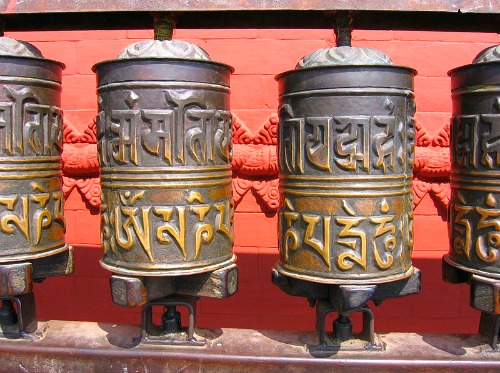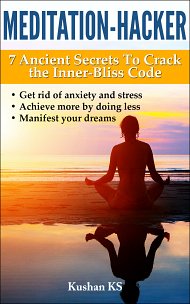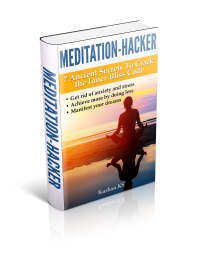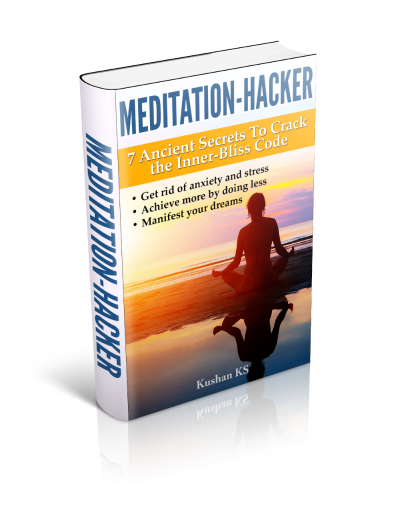Mantra Meditation
"Bijakshara (seed-letter) is the supreme Bindu (point/center). Nada (spiritual sound) is above it. When that Nada ceases along with the letter, the Nada-less is the supreme state"
- Dhyana Bindu Upanishad

Mantra meditation is the basis of arguably the most well-known form of meditation in the West, Transcendental Meditation (TM).
Mantra comes from ancient Sanskrit and can be literally translated as 'instrument of thought.'
The most basic mantra is Om (Aum), which in Hinduism is known to be the source of all mantras.
Om is believed to be the primordial or the 'first' sound of the universe generated by the cosmic vibration that resulted in all creation (think Big Bang). The Bible also says...the beginning came from the word.
Just like our thoughts, words are a form of energy, which is quite evident in their palpable frequency and vibrations. Words carry within them the seeds of creation and are a powerful force for bringing into existence that which only exists in the ethereal plane.
What is a mantra?
A mantra is a word or phrase whose recital raises the level of consciousness by bringing about greater awareness. It opens the doorway to a deeper understanding of the self and of the laws of nature.
Buddhists use the recitation of verses as a way of cultivating an awareness of the qualities of the Buddha. Followers of the 13th century Japanese Buddhist monk, Nichiren Daishonin, chant Nam Myōhō Renge Kyō (Lotus Sutra) as the exclusive means to attain enlightenment.
It is understood that through mantra repetition, the practitioner attains unity with the chosen deity or principal idea of the mantra. The vibrations and sounds of the mantra awaken the spiritual life force and
stimulate the chakras of the practitioner.
What mantra to use?
Any verse from the holy texts like the Bible, Quran, Adi Granth, Vedas, Upanishads, Yoga Sutra and others is considered powerful enough to be repeated to great effect, and can be used for mantra meditation.
A few examples are listed below:
- Ma-ra-na-tha
The word Maranatha is the final instruction of St. Paul's teachings to the Corinthians. It is also St. John's final instruction in the Book of Revelations. Thus, the last word, the final teaching of the entire Christian Bible is "Maranatha," which is Aramaic for "Come Lord"
- Allah Hu
It is the traditional Sufi chant meaning "God is"
- Asato mā sad gamaya,
Tamaso mā jyotir gamaya,
mṛtyor mā amṛtaṁ gamaya
Oṁ śānti śānti śāntiḥ
From ignorance, lead me to truth;
From darkness, lead me to light;
From death, lead me to immortality
Om peace, peace, peace
- Sarve bhavantu sukhinaḥ
Sarve santu nirāmayāḥ
Sarve bhadrāṇi paśyantu
Mā kaścit duḥkha bhāgbhavet
May all be happy. May all be healthy.
May we all experience what is good, and let no one suffer
- Om mani padme hum
There are various interpretations of this Buddhist mantra, but according to the XIV Dalia Lama, it means "in dependence on the practice of a path, which is an indivisible union of method and wisdom, you can transform your impure body, speech, and mind into the pure exalted body, speech, and mind of a Buddha"
- Ek Om Kar, Sat Nam, Karta Purkh, Nirbhao, Nirvair, Akaal moort, Ajuni, Sai Bhang, Gur Prasad
Sikhism's mool mantra translates into One God, the true name, the creator, without fear, without hatred, timeless, self-existent, made known by the Guru
The word or phrase used for doing mantra meditation need not have a deeper meaning or be significant in any way.
Practitioners of transcendental meditation use monosyllables like ing, im, aing, aim, shring, shrim, shiam and shiama to do meditation.
Every person born in this world has a unique sound associated with them. This beej (seed) mantra is derived from the sound of each individual's nakshatra-pada.
Knowledge of the nakshatra-pada allows one to create a mantra unique to the individual and one that is in harmony with the universal forces.
Your can find your own personal beej mantra on the primordial sound meditation page.
How to do mantra meditation?
Once you have decided upon the mantra to use for your meditation, begin your session with:
- observing a minute of silence with closed eyes
- start chanting the mantra gently for 10-15 minutes
- finish by sitting still for a couple of minutes with no chanting toward the end
It is recommended to do mantra meditation for 15-20 minutes twice a day.
You can complement your mantra meditation practice with visualization meditation, object focused meditation, walking meditation or body scanning meditation.
Return from Mantra Meditation to Beginners Guide

Get my book, Meditation-Hacker: 7 Ancient Secrets to Crack the Inner-Bliss Code and receive valuable information on meditation that you can use to improve the quality of your health and life.


Comments
I would love to hear your meditation experiences. And, if you are a beginner, your questions and apprehensions about meditation. Comment below or contact me directly through the navigation bar on the left of this page.